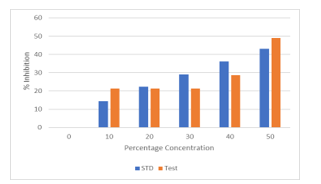Evaluation of Antiurolithiatic Activity by In-Vitro Methods
Main Article Content
Abstract
In the present study, in vitro methods are used to evaluate of anti urolithiatic activity of polyherbal tablets. In in-vitro study there are several models includes Kramer and Tisdall’stitrimetry model, turbidimetric study by using simple NaCl solution, turbidimetric study by using artificial urine model, microscopic study, crystal inhibition on gel model, etc. Among these we have used Kramer and Tisdall’stitrimetry model, turbidimetric study by using simple NaCl solution, turbidimetric study by using artificial urine model, microscopic study.
Article Details
References
Cotran R. S., Kumar V., Collins T. Robbins “Pathologic Basis of Disease.” 6thed. Philadelphia: Elsevier Saunders;. P.962, 963, 2005.
Dey N. C., Dey T. K. “Text Book of Pathology.” 15th revised ed. New Delhi: New Central Book Agency (P) Ltd, P.20.46-20.49, 2009.
Waugh Anne, Grant Allison. “Ross and Wilson Anatomy and Physiology in Health and Illness.” 10th ed. UK: Churchill Livingstone Elsevier; P. 351, 352, 2006.
Tilahun Alelign, Beyene Petros. “Kidney Stone Disease: An Update on Current Concepts.”Advances in Urology; 1:1-12, 2018.
Dr. R. Kalai, B. Sasirekha. Dietary Guidelines to Reduce the Risk of Renal Stones. International Journal of Nursing Education and Research.; 06(01):73-77, 2018.
Khandelwal KR, Sethi V. Practical Pharmacognosy, 13th ed. Pune: Nirali Prakashan, 149-56 p, 2005.
Madike LN, Takaidza S, Pillay M. Preliminary phytochemical screening of crude extracts from the leaves, stems, and roots of Tulbaghiaviolacea. Int JPharmacogn Phytochem Res., 9(10):1300-8,2017.
Khar Roop, Vyas S. P., Ahmad Farhan J., Jain Gaurav K. “The theory and practice of Industrial pharmacy.” 4thed. India: CBS publishers and Distribution Pvt. Ltd, P.470-472, 479- 488, 2013.
Government of India Ministry of Health and Family Welfare. Indian Pharmacopoeia. Vol. II Ghaziabad: The Indian pharmacopoeia commission; P.959, 960, 2014.
Karunasree Varicola, Sushmitha Metla, Urmila Sri Syamala, Sravya Rajulapati. “Assessment of Potential Antiurolithiatic Activity of Some Selected Medicinal Plants by In vitro Techniques.”Acta Scientific Pharmaceutical Sciences;1(2):38-42, 2017.
Byahatti Vivek V., Pai K. Vasantakumar, D’Souza Marina G. “Effect of phenolic compounds from Bergeniaciliata (Haw) sternb. leaves on experimental kidney stones.” Ancient Science of Life; 30 (1):14-17, 2010.
Rohan Sharadan and Phatak, Anup Subhash Hendre. “In-vitro Antiurolithiatic Activity of Kalanchoepinnata Extract.” International Journal of Pharmacognosy and Phytochemical Research.;7(2);275-279, 2015.
Neeraja Kamakshi U., Ganga Rao B., Venkateswara Rao B. “Comparison of In vitro Antiurolithiatic Activity of Aervalanata, Sphaeranthusindicus, Merremiaemarginata.”Research Journal of Pharmacy and Technology.;10 (6):1653-1656, 2017.
Amritan Kachru, Monika Bisht, Mamta Baunthiyal. “In vitro evaluation of anti-neprolithiatic activity of leaves and seeds of Macrotylomauniflorumon dissolution or removal of kidney stones.”Research Journal of Pharmacognosy & Phytochemistry. ;8(1):05-12, 2016.
Chitra Devi V., Mothil S., Tamizharasi S. “Calcium oxalate crystallization inhibition by Pedalium murex and Tribulusterrestris fruit extracts.” International Journal of ChemTech Research.;10(3):128-136, 2017.
Goyal Parveen Kumar, Mittal Arun, Kumar Rishi. “Evaluation of Tinosporacordifolia for Antiurolithiatic Potential.” Journal of Pharmaceutical and Biomedical

